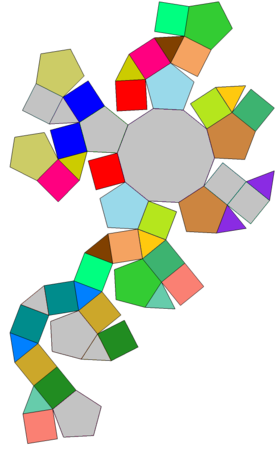
In geometry, a Johnson solid is a strictly convex polyhedron each face of which is a regular polygon. There is no requirement that each face must be the same polygon, or that the same polygons join around each vertex. An example of a Johnson solid is the square-based pyramid with equilateral sides ; it has 1 square face and 4 triangular faces. Some authors require that the solid not be uniform before they refer to it as a “Johnson solid”.

In geometry, the gyroelongated square cupola is one of the Johnson solids (J23). As the name suggests, it can be constructed by gyroelongating a square cupola (J4) by attaching an octagonal antiprism to its base. It can also be seen as a gyroelongated square bicupola (J45) with one square bicupola removed.

In geometry, the pentagonal cupola is one of the Johnson solids. It can be obtained as a slice of the rhombicosidodecahedron. The pentagonal cupola consists of 5 equilateral triangles, 5 squares, 1 pentagon, and 1 decagon.

In geometry, the diminished rhombicosidodecahedron is one of the Johnson solids. It can be constructed as a rhombicosidodecahedron with one pentagonal cupola removed.

In geometry, the gyrate rhombicosidodecahedron is one of the Johnson solids. It is also a canonical polyhedron.

In geometry, the parabidiminished rhombicosidodecahedron is one of the Johnson solids. It is also a canonical polyhedron.

In geometry, the metabidiminished rhombicosidodecahedron is one of the Johnson solids.

In geometry, the tridiminished rhombicosidodecahedron is one of the Johnson solids. It can be constructed as a rhombicosidodecahedron with three pentagonal cupolae removed.

In geometry, the trigyrate rhombicosidodecahedron is one of the Johnson solids. It contains 20 triangles, 30 squares and 12 pentagons. It is also a canonical polyhedron.
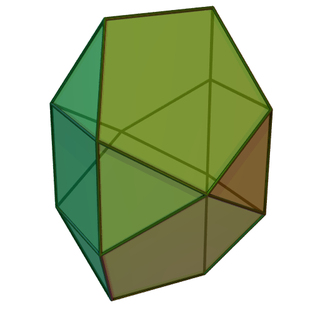
In geometry, the bilunabirotunda is one of the Johnson solids. A Johnson solid is one of 92 strictly convex polyhedra that is composed of regular polygon faces but are not uniform polyhedra. They were named by Norman Johnson, who first listed these polyhedra in 1966.

In geometry, the elongated pentagonal cupola is one of the Johnson solids. As the name suggests, it can be constructed by elongating a pentagonal cupola by attaching a decagonal prism to its base. The solid can also be seen as an elongated pentagonal orthobicupola with its "lid" removed.
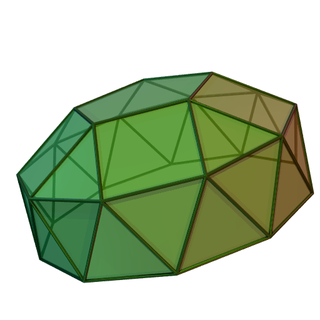
In geometry, the gyroelongated pentagonal cupola is one of the Johnson solids (J24). As the name suggests, it can be constructed by gyroelongating a pentagonal cupola (J5) by attaching a decagonal antiprism to its base. It can also be seen as a gyroelongated pentagonal bicupola (J46) with one pentagonal cupola removed.

In geometry, the pentagonal gyrobicupola is one of the Johnson solids. Like the pentagonal orthobicupola, it can be obtained by joining two pentagonal cupolae along their bases. The difference is that in this solid, the two halves are rotated 36 degrees with respect to one another.

In geometry, the parabigyrate rhombicosidodecahedron is one of the Johnson solids. It can be constructed as a rhombicosidodecahedron with two opposing pentagonal cupolae rotated through 36 degrees. It is also a canonical polyhedron.

In geometry, the paragyrate diminished rhombicosidodecahedron is one of the Johnson solids. It can be constructed as a rhombicosidodecahedron with one pentagonal cupola rotated through 36 degrees, and the opposing pentagonal cupola removed.

In geometry, the bigyrate diminished rhombicosidodecahedron is one of the Johnson solids. It can be constructed as a rhombicosidodecahedron with two pentagonal cupolae rotated through 36 degrees, and a third pentagonal cupola removed.
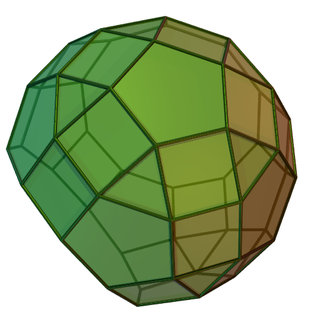
In geometry, the gyrate bidiminished rhombicosidodecahedron is one of the Johnson solids.
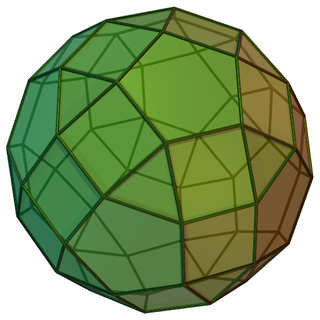
In geometry, the metabigyrate rhombicosidodecahedron is one of the Johnson solids. It can be constructed as a rhombicosidodecahedron with two non-opposing pentagonal cupolae rotated through 36 degrees. It is also a canonical polyhedron.
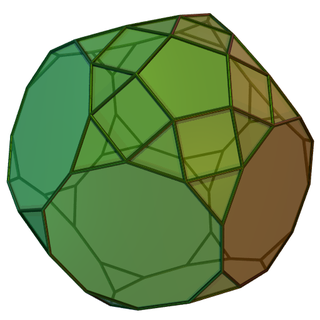
In geometry, the augmented truncated dodecahedron is one of the Johnson solids. As its name suggests, it is created by attaching a pentagonal cupola onto one decagonal face of a truncated dodecahedron.
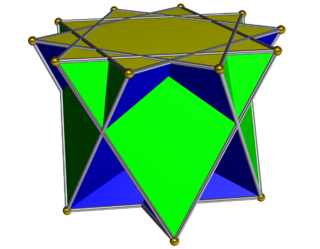
In geometry, the crossed pentagrammic cupola is one of the nonconvex Johnson solid isomorphs, being topologically identical to the convex pentagonal cupola. It can be obtained as a slice of the great rhombicosidodecahedron or quasirhombicosidodecahedron. As in all cupolae, the base polygon has twice as many edges and vertices as the top; in this case the base polygon is a decagram.
This page is based on this
Wikipedia article Text is available under the
CC BY-SA 4.0 license; additional terms may apply.
Images, videos and audio are available under their respective licenses.

